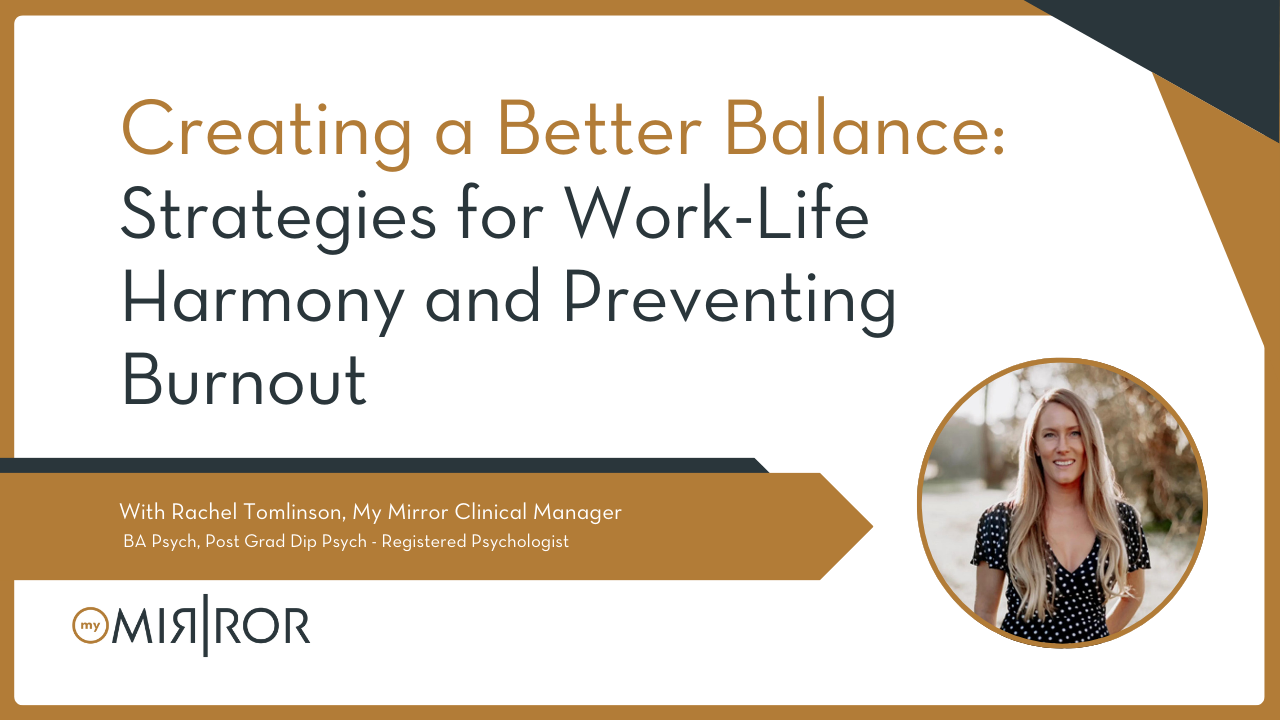Are you looking to set boundaries, prioritize self-care, and manage stress effectively while maintaining a fulfilling work-life balance? Whether you're dealing with burnout or seeking a better balance, My Mirror presents Creating a Balance: Strategies for Work-Life Harmony and Preventing Burnout workshop, offering valuable tips to help you thrive both personally and professionally.
Watch the full recording now and start creating a healthier, more sustainable lifestyle!
My Mirror online workshop presented by Rachel Tomlinson

In our fast-paced world, achieving a healthy work-life balance can be difficult. We need to manage the demands of long working hours that can often extend beyond the office and our contracted working hours, with technology blurring the lines between work and home life.
Being constantly connected can increase the risk of burnout and impact our overall health and well-being. We see media campaigns and trends like “quiet quitting” or “mediocre Mondays” which highlight just how stretched and overwhelmed people are which makes it all the more crucial to address the underlying issues that contribute to this growing problem.
What proactive steps can we take to avoid burnout? Identifying personal triggers and stressors is a crucial first step. By understanding what leads to feelings of overwhelm, we can implement strategies tailored to our unique situations.
How to recognise the early signs of burnout

Burnout isn’t something that happens overnight. It's a gradual process as we experience stress that accumulates over time, and we don’t have enough time to recover fully between periods of stress or overwhelm. Burnout arises from an imbalance between the demands of a job role and the resources you have available to help you cope with those demands. If someone is under pressure and they don’t have the chance to recover and recharge eventually they start to see their performance and wellbeing suffer.
Warning signs of burnout can include things like; fatigue, irritability, feeling detached from work/clients, reduced productivity, and even cynicism. In addition, people may experience physical symptoms like headaches or digestive issues like stomach upsets.
If you’re experiencing severe burnout, we suggest reaching out to a psychologist. You can use our matching tool to find a psychologist who fits your needs and schedule.
How does work-life balance help prevent burnout?

So what does a healthy work-life balance look like? It's important to note that this can look different to each person depending on what they need in their life, as well as their individual strengths or characteristics. But in a general sense, it is the balance between the time and energy dedicated to work and that of their personal life. When work starts to encroach on personal or family time, it can result in stress, less time to engage in hobbies or other activities that lead to fulfilment and personal growth, but it also has the potential to impact the quality of relationships. On the flip side, if personal life is prioritised over work, it can result in reduced output or outcomes at work, job dissatisfaction and stagnation in career progression.
Having a balance between work and life allows people to meet professional obligations while simultaneously having enough time and energy (physical and emotional energy) to take care of their physical, emotional, and social needs. Again, while this balance will look different for everyone, it's important to note that it's not about equally dividing time between work and home but finding a way to integrate both elements harmoniously to allow for fulfilment in both areas.
How to prevent and avoid burnout?

Establish clear boundaries between work and personal life
One of the most effective ways to achieve work-life balance is to learn how to set boundaries between work and personal life. This could include things like communicating to colleagues your expectations, or boundaries, it could be about committing to leaving work on time or only picking up calls or checking emails at certain times or under certain circumstances after hours.
Understanding that saying no is okay
Saying no can be challenging for many people. They worry about disappointing others or the impact of what might happen if they do say no. However, this can lead to taking on more work than is achievable (or more than is good for their wellbeing and health). Learning how to have a difficult conversation and ultimately saying no when necessary is vital in maintaining balance at work and in your personal life.
Embrace digital detox
Try to plan regular digital detoxes. We are constantly connected to technology and this makes it harder to draw the line when it comes to disconnecting from work. You could set your phone to do not disturb during certain periods, silence notifications or even move your phone away from you. Depending on your role you may need to be accessible, but see if you can carve out specific times of the day where you can fully disconnect and prioritise personal activities and relationships.
Adopt Mindfulness Practices
We spend so much time rushing around, and worrying about the next thing or trying to multitask that it's hard for many of us to pause and unwind. Mindfulness is the practice of being present in the moment without judgment. When you incorporate mindfulness into your day it can help you manage stress and maintain balance. Mindfulness covers a range of techniques and activities to help you keep calm and relaxed, including; meditation, calm breathing or grounding strategies.
Prioritise the importance of self-care
Self-care is not a luxury; it's a necessity. It's not all about massages, or “treating” yourself either. True self-care is about prioritising time for activities that give you energy or promote physical and emotional well-being. This will look different for everyone, as some people are energised by being around others but some are energised when they have some alone time. But some good ideas to get you thinking about self-care could include; exercise, eating healthy, getting enough sleep, learning something new, or even saying “no” and clearing your schedule.
Connect with support services when needed
If you're feeling overwhelmed, don't hesitate to seek support. You don’t need to be in crisis or have a mental health diagnosis to connect with a psychologist, they can provide valuable insights and coping strategies to help you manage stress, implement boundaries and find a better balance.
Achieving work-life balance is an ongoing process that requires conscious effort and self-awareness. It's something that you will need to review and assess as your needs and preferences will change over time – depending on what is happening in your world. By learning how to set (and keep) boundaries, practice self-care, and reach out for support when you need it, you can minimise the risk of burnout and create a more fulfilling and balanced life. Remember, that balance doesn’t mean perfection, nor does it mean the same thing for every person. It's about finding what works for you, paying attention to how you are feeling, and tweaking and adjusting things. With the right strategies in place, you can thrive and feel fulfilled in both your work and personal life.

Feeling overworked and stressed can often signal a deeper issue with burnout—a condition that gradually creeps in as the balance between work demands and personal well-being shifts. Achieving a healthy work-life balance is not just a goal but a continuous process that requires self-awareness and intentional effort. By setting clear boundaries, learning to say no, implementing digital detoxes, practising mindfulness, prioritizing self-care, and seeking support when needed, you can effectively manage and prevent burnout.
